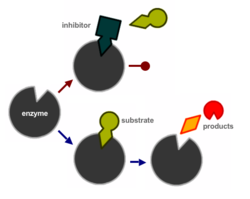PCR inhibitors: Difference between revisions
From OpenWetWare
Jump to navigationJump to search
| Line 22: | Line 22: | ||
== See also == | == See also == | ||
* [[Maheshri:PCR]] - has some tips on how to avoid inhibition | |||
* [[PCR]] - general, simple overview of polymerase chain reaction | |||
* [[PCR techniques]] - hub page for PCR-based techniques | |||
* [[Purification of DNA]] | |||
[[Category:PCR]] [[Category:DNA]] [[Category:In vitro]] [[Category:Chemicals]] | [[Category:PCR]] [[Category:DNA]] [[Category:In vitro]] [[Category:Chemicals]] | ||
Revision as of 05:05, 7 July 2010

Many compounds also contained in the PCR template beside the target DNA can interfere with the polymerisation of nucleotides by the Taq or a related polymerase. This may result in false negative results, i.e. no PCR product even though the template is present.
Inhibitors from the purification process
- alcohols like ethanol and 2-propanol (isopropanol) from DNA template precipitation (Qiagen test of sequencing inhibition by Welters et al. 1997)
- organic solvents like phenol from phenol/chloroform purification (PMID 8136148)
- salts like KCl, NaCl from precipitation
- detergents like SDS,.. from membrane lysis (PMID 2223070)
Inhibitors from the source tissue
- components of blood: heme, hemoglobin, lactoferrin, immunoglobin G (IgG)
- liver, digestive tract, feces: bile salts, polysaccharides
- connective tissue, skin: collagen, melanin
- urine: urea
See Rådström et al. 2004 (PMID 14764939) for a review on how to avoid inhibition from tissue components.
Template inhibition
See also
- Maheshri:PCR - has some tips on how to avoid inhibition
- PCR - general, simple overview of polymerase chain reaction
- PCR techniques - hub page for PCR-based techniques
- Purification of DNA